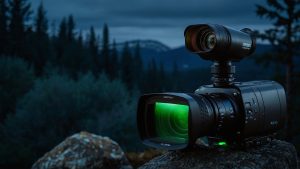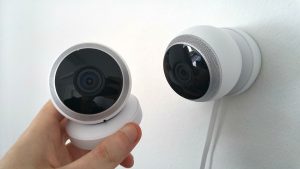When it comes to securing your home, the placement of your security cameras can make all the difference between catching the intruder or missing vital footage.
From the front door to the backyard, each spot serves a crucial role in safeguarding your property. However, some locations can do more harm than good, leaving your home vulnerable to potential threats.
Before making any decisions, consider the implications of overlooking these key areas.
Front Door

When considering home security cameras, the front door is a crucial location to focus on for optimal surveillance coverage. Entryway visibility is key to deterring potential intruders and capturing important footage in case of any suspicious activity. Placing a camera at the front door provides a clear view of anyone approaching or trying to gain access to your home.
However, there are camera placement restrictions to keep in mind when installing a security camera at the front door. It's essential to position the camera high enough to prevent tampering or vandalism. Placing it at eye level can make it easier for intruders to disable or avoid detection. Additionally, be mindful of any obstructions such as plants or decorations that could block the camera's view or create blind spots.
To ensure comprehensive coverage, consider installing a wide-angle lens camera that can capture a broader area around the front door. This type of camera allows you to monitor not only the immediate vicinity of the door but also the surrounding space, providing a more comprehensive view of any potential threats.
Backyard
For optimal surveillance coverage in your backyard, consider strategic camera placement to ensure comprehensive monitoring of the outdoor space. When securing your backyard with security cameras, focus on key areas that are vulnerable to intrusion or require monitoring.
- Hidden corners: Place cameras in hidden corners of your backyard where intruders may attempt to hide or gain unauthorized access. These blind spots are critical areas that need monitoring to prevent any potential security breaches.
- Outdoor lighting: Ensure your security cameras in the backyard are well-positioned to take advantage of outdoor lighting. Proper lighting not only deters intruders but also enhances the quality of footage captured by your cameras, especially during nighttime surveillance.
- High vantage points: Mount cameras in elevated positions to have a wide-angle view of your backyard. This vantage point allows for better coverage and monitoring of the entire outdoor area, minimizing the risk of blind spots or areas outside the camera's range.
Strategically placing your security cameras in the backyard, focusing on hidden corners, utilizing outdoor lighting effectively, and considering high vantage points will help bolster the overall security of your home. By following these guidelines, you can ensure that your backyard is well-protected and under constant surveillance.
Garage

Consider mounting security cameras strategically in your garage to ensure comprehensive surveillance coverage of this critical area in your home. When deciding where to place your cameras, focus on key areas such as garage entrances and driveway surveillance to enhance the security of your property effectively. By strategically positioning cameras in these locations, you can monitor any suspicious activity, deter potential intruders, and enhance the overall safety of your home.
Garage Surveillance Points
| Location | Camera Type | Benefits |
|---|---|---|
| Garage Entrance | Wide-Angle Camera | Monitor who enters and exits the garage |
| Driveway | Pan-Tilt-Zoom | Cover a wide area for complete driveway surveillance |
| Tool Storage Area | Fixed Camera | Keep an eye on valuable tools and equipment |
Placing a wide-angle camera at the garage entrance allows you to capture clear footage of individuals entering or leaving the garage, providing valuable information in case of any security incidents. A pan-tilt-zoom camera overlooking the driveway ensures comprehensive coverage, allowing you to monitor vehicles and activities in this critical area effectively. Additionally, installing a fixed camera near the tool storage area helps safeguard your valuable equipment from theft or unauthorized access. By strategically positioning cameras in these key locations within your garage, you can enhance the security of your home and enjoy peace of mind knowing that your property is well-protected.
Windows
Strategically positioning security cameras near windows is crucial for comprehensive home surveillance. When it comes to placing cameras by windows, there are a few key considerations to keep in mind:
- Privacy concerns: Placing cameras too close to windows may inadvertently capture footage of your neighbors or public spaces, raising privacy issues. To mitigate this, angle the cameras slightly away from the window or use blinds or curtains to block the view partially.
- Reflection issues: Windows can cause glare and reflection problems, affecting the clarity of the camera footage. To combat this, opt for cameras with anti-glare technology or infrared capabilities to ensure clear images even when faced with reflective surfaces.
- Optimal placement: Position cameras at a higher vantage point near windows to capture a wider field of view and minimize obstructions. This placement can help monitor both the interior and exterior of your home effectively.
Hallways

When installing security cameras in your home, ensuring proper coverage of hallways is essential for comprehensive surveillance. Hallways act as the main thoroughfare in most homes, making them a crucial area to monitor for any suspicious activity. To maximize the effectiveness of your security system, consider the following aspects when placing cameras in hallways:
| Aspects | Recommendations |
|---|---|
| Staircase Visibility | Position cameras to capture clear footage of staircase areas. This is important for monitoring movements up and down the stairs, which can be a common entry point for intruders. By having a camera focused on the staircase, you can enhance your overall home security. |
| Entryway Coverage | Ensure that your cameras cover both ends of the hallway, including the entry points from other rooms or the main entrance. This comprehensive coverage will help in tracking any individuals entering or exiting the hallway. It is advisable to have overlapping coverage from multiple angles to reduce blind spots and improve surveillance efficiency. |
Blind Spots
To ensure comprehensive surveillance, it's crucial to address potential blind spots when positioning home security cameras. When setting up your security system, be mindful of the following:
- Hidden corners: These areas are often overlooked but can provide cover for intruders. Place cameras strategically to cover these spots, ensuring there are no areas where suspicious activity could go unnoticed.
- High ceilings: Cameras placed too high may not capture detailed facial features or activities happening at ground level. Adjust the angle or consider additional cameras to compensate for this blind spot.
- Obstructions: Objects like trees, bushes, or decorative elements can obstruct the camera's view, creating blind spots. Regularly check for any new obstructions that may have appeared and adjust your cameras accordingly.
Frequently Asked Questions
Can Home Security Cameras Be Easily Hacked by Intruders?
When it comes to home security cameras, cybercriminals pose a threat as they can potentially hack into your system, leading to privacy breaches.
It's crucial to secure your cameras with strong passwords, enable two-factor authentication, and regularly update the firmware to mitigate cybersecurity risks.
Are There Any Legal Restrictions on Where I Can Place My Home Security Cameras?
When it comes to placing your home security cameras, it's important to be aware of legal restrictions. Privacy concerns dictate that you shouldn't point cameras at areas where people have a reasonable expectation of privacy, like bathrooms or bedrooms.
Additionally, it's vital to respect property boundaries and avoid aiming cameras at your neighbor's property without their consent. Always ensure your cameras comply with local laws to prevent any legal issues down the line.
How Can I Prevent My Security Cameras From Being Tampered With or Disabled?
To prevent tampering or disabling of your security cameras, consider using tamper-proof mounting solutions. These specialized mounts are designed to deter any attempts to interfere with the cameras.
Additionally, utilizing remote access control allows you to monitor and manage your cameras from anywhere, reducing the risk of physical tampering.
What Type of Lighting Is Best for Ensuring Clear Footage From Security Cameras?
For ensuring clear footage from security cameras, consider the type of lighting in both outdoor and indoor settings.
Outdoor cameras benefit from natural lighting, such as sunlight, which provides optimal visibility. Artificial lighting, like LED lights, can enhance nighttime footage quality.
In indoor spaces, a balance of natural light and strategically placed artificial lighting can help maintain clear visuals. Understanding the light sources in your environment is crucial for maximizing security camera effectiveness.
Are There Any Additional Features or Technologies I Should Consider for Optimal Home Security Camera Placement?
When considering optimal home security camera placement, look into advanced analytics for enhanced monitoring.
Smart alerts and customized settings can also improve your surveillance system.
Technology like remote monitoring can offer real-time insights and peace of mind.



